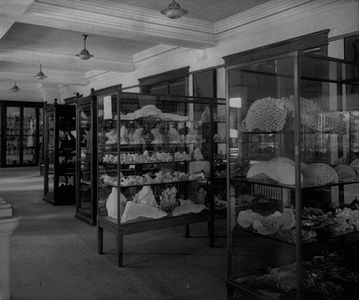Deseret Museum
The Deseret Museum, the first museum in Utah, opened in December 1869. Originally called the Salt Lake City Museum and Menagerie but due to its location in a two-room adobe home west of the Lion House—one of the first homes constructed in the Salt Lake Valley—it was known as the Home Museum. Some of the early donations to the museum were live animals, so it became the Home Museum and Menagerie. The inside of the home was the museum and the animal cages were outside.
John W. Young, a son of Brigham Young and Guglielmo Giosue Rosetti Sangiovanni conceived the idea of a museum in the fall of 1867. They believed that a display of some sort would enable visitors to the territory of Deseret to see its resources. Their plan was to include native animals, specimens, and other curiosities. However, when the Utah Territorial Legislature declined the opportunity to support the museum on a public basis, Young moved forward on a private basis.
He placed the following advertisement in the Deseret Evening News on November 26, 1869:
- FRIENDS OF SCIENCE and of the progress of the Territory will oblige me by preserving ANIMALS and BIRDS indigenous to the Rocky Mountains, as I will gladly purchase them for our Home Museum. If any prefer to contribute rather than sell, they will not be refused. Contributions of every kind that will add to the interest and usefulness of the Museum will be received and properly cared for with pleasure.
- For further particulars inquire of G. G. R. Sangiovanni, at my residence opposite the City Hall. JOHN W. YOUNG
The first contribution was a pair of black bears. James E. Talmage noted, “Many things were brought and many more donated. The miner, the artisan, the hunter, and in fact citizens of all classes brought their contributions.”[1] President Brigham Young contributed many things from his private collection. Missionaries returning from their labors for The Church of Jesus Christ of Latter-day Saints brought items to the museum. The growing mining industry provided minerals to the collection. “Within the first six months an extensive fossil collection, including the complete specimen of a mastodon, was obtained.”[2]
Sangiovanni, known as “Sangio,” became the museum’s first curator. Joseph L. Barfoot, who was in the employ of Brigham Young at his residence, began to classify the specimens and relics. He became the second curator when Sangio left in 1871. Professor Barfoot wrote hundreds of short articles on scientific topics for the Church’s Juvenile Instructor. He also wrote "Brief History of the Deseret Museum" in 1880 and "Handbook Guide to the Salt Lake Museum" in 1881.
The Deseret Evening News promoted the museum and a twenty-five cent entrance fee was charged. Many visitors included curious children and distinguished educators and scientists. Over time, the menagerie part disappeared, and the museum out grew its small home. In May 1871, the collections were relocated to another adobe home.
When John W. Young realized that the museum needed more support than one man “could be expected to afford,” the ownership of the museum was transferred to The Church of Jesus Christ of Latter-day Saints and the proprietor-in-trust became Church president John Taylor.
Joseph L. Barfoot died on April 23, 1882, and until a new curator, specifically James E. Talmage, was appointed in January 1891, the collection was cared for but mostly just survived. In June 1885, citizens formed the Salt Lake Literary and Scientific Association and took possession of the museum and Don Carlos Young and George Reynolds kept the collection from dissolving. In December 1890, Talmage was given charge of the collections. Under his care, the museum moved to a new location in the Templeton Building. Also under his care, the collections grew and the Deseret Museum became a member in the Museums Association headquartered in London, England.
The Deseret Museum was housed in the Church University Building from March 1893 to July 1903. “The April 20, 1895, issue of Scientific American featured this museum with an article and several pictures, noting its extensive collections.”[3]
Ownership of the museum reverted to the Church of Jesus Christ in November 1899. When the title to the building was passed to the University of Utah in 1903, the museum collections were boxed and stored in the Salt Lake Temple. Even though the collection was in storage, the Deseret Museum became a charter member of the American Association of Museums and continued to grow. The museum reopened on July 11, 1911, in the Vermont Building. The collection became free to the public.
Even after Talmage was called to the Quorum of the Twelve Apostles in December 1911, he continued as director with the wish of the First Presidency and the Quorum of the Twelve. His son Sterling B. Talmage, was appointed curator.
In 1919, the museum moved to the Bureau of Information on Temple Square, and the Deseret Museum ceased functioning as a separate institution. Its collection began to be dispersed to other locations: some to the Monte L. Bean Life Sciences Museum and the Geology Department of Brigham Young University, some to the Church History Museum, some to the Daughters of Utah Pioneers Museum, and some to the Museum of Peoples and Cultures at BYU. Some specimens are located at the Utah Museum of Natural History at the University of Utah.
“The Deseret Museum accomplished its original purpose and more. It acquainted visitors with Utah's pioneer and natural history, served as an educational and cultural aid to the community, made a valuable contribution to the preservation of artifacts pertaining to Utah and Mormon history, gathered and preserved large quantities of scientific specimens, and contributed to the formation of other museums and collections that continue to instruct and edify.”[4]
